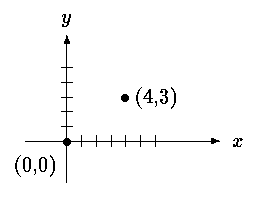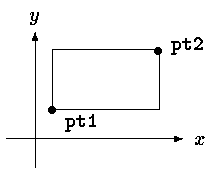Basics of Structures in C
By: Grenfel in C Tutorials on 2007-09-22
The keyword struct introduces a structure declaration, which is a list of declarations enclosed in braces. An optional name called a structure tag may follow the word struct (as with point here). The tag names this kind of structure, and can be used subsequently as a shorthand for the part of the declaration in braces.The variables named in a structure are called members. A structure member or tag and an ordinary (i.e., non-member) variable can have the same name without conflict, since they can always be distinguished by context. Furthermore, the same member names may occur in different structures, although as a matter of style one would normally use the same names only for closely related objects.
Let us create a few structures suitable for graphics. The basic object is a point, which we will assume has an x coordinate and a y coordinate, both integers.

The two components can be placed in a structure declared like this:
struct point {
int x;
int y;
};
A struct declaration defines a type. The right brace that terminates the list of members may be followed by a list of variables, just as for any basic type. That is,
struct { ... } x, y, z;
is syntactically analogous to
int x, y, z;in the sense that each statement declares x, y and z to be variables of the named type and causes space to be set aside for them.
A structure declaration that is not followed by a list of variables reserves no storage; it merely describes a template or shape of a structure. If the declaration is tagged, however, the tag can be used later in definitions of instances of the structure. For example, given the declaration of point above,
struct point pt;defines a variable pt which is a structure of type struct point. A structure can be initialized by following its definition with a list of initializers, each a constant expression, for the members:
struct maxpt = { 320, 200 };
An automatic structure may also be initialized by assignment or by calling a
function that returns a structure of the right type.
A member of a particular structure is referred to in an expression by a construction of the form
structure-name.member
The structure member operator ``.'' connects the structure name and the member name. To print the coordinates of the point pt, for instance,
printf("%d,%d", pt.x, pt.y);
or to compute the distance from the origin (0,0) to pt,
double dist, sqrt(double); dist = sqrt((double)pt.x * pt.x + (double)pt.y * pt.y);Structures can be nested. One representation of a rectangle is a pair of points that denote the diagonally opposite corners:

struct rect {
struct point pt1;
struct point pt2;
};
The rect structure contains two point structures. If we
declare screen as
struct rect screen;then
screen.pt1.xrefers to the x coordinate of the pt1 member of screen.
Add Comment
This policy contains information about your privacy. By posting, you are declaring that you understand this policy:
- Your name, rating, website address, town, country, state and comment will be publicly displayed if entered.
- Aside from the data entered into these form fields, other stored data about your comment will include:
- Your IP address (not displayed)
- The time/date of your submission (displayed)
- Your email address will not be shared. It is collected for only two reasons:
- Administrative purposes, should a need to contact you arise.
- To inform you of new comments, should you subscribe to receive notifications.
- A cookie may be set on your computer. This is used to remember your inputs. It will expire by itself.
This policy is subject to change at any time and without notice.
These terms and conditions contain rules about posting comments. By submitting a comment, you are declaring that you agree with these rules:
- Although the administrator will attempt to moderate comments, it is impossible for every comment to have been moderated at any given time.
- You acknowledge that all comments express the views and opinions of the original author and not those of the administrator.
- You agree not to post any material which is knowingly false, obscene, hateful, threatening, harassing or invasive of a person's privacy.
- The administrator has the right to edit, move or remove any comment for any reason and without notice.
Failure to comply with these rules may result in being banned from submitting further comments.
These terms and conditions are subject to change at any time and without notice.
|
Most Viewed Articles (in C ) |
Latest Articles (in C) |
- Data Science
- Android
- React Native
- AJAX
- ASP.net
- C
- C++
- C#
- Cocoa
- Cloud Computing
- HTML5
- Java
- Javascript
- JSF
- JSP
- J2ME
- Java Beans
- EJB
- JDBC
- Linux
- Mac OS X
- iPhone
- MySQL
- Office 365
- Perl
- PHP
- Python
- Ruby
- VB.net
- Hibernate
- Struts
- SAP
- Trends
- Tech Reviews
- WebServices
- XML
- Certification
- Interview
categories
Related Tutorials
Sum of the elements of an array in C
Printing a simple histogram in C
Find square and square root for a given number in C
Simple arithmetic calculations in C
Passing double value to a function in C
Passing pointer to a function in C
Infix to Prefix And Postfix in C
while, do while and for loops in C
Comments